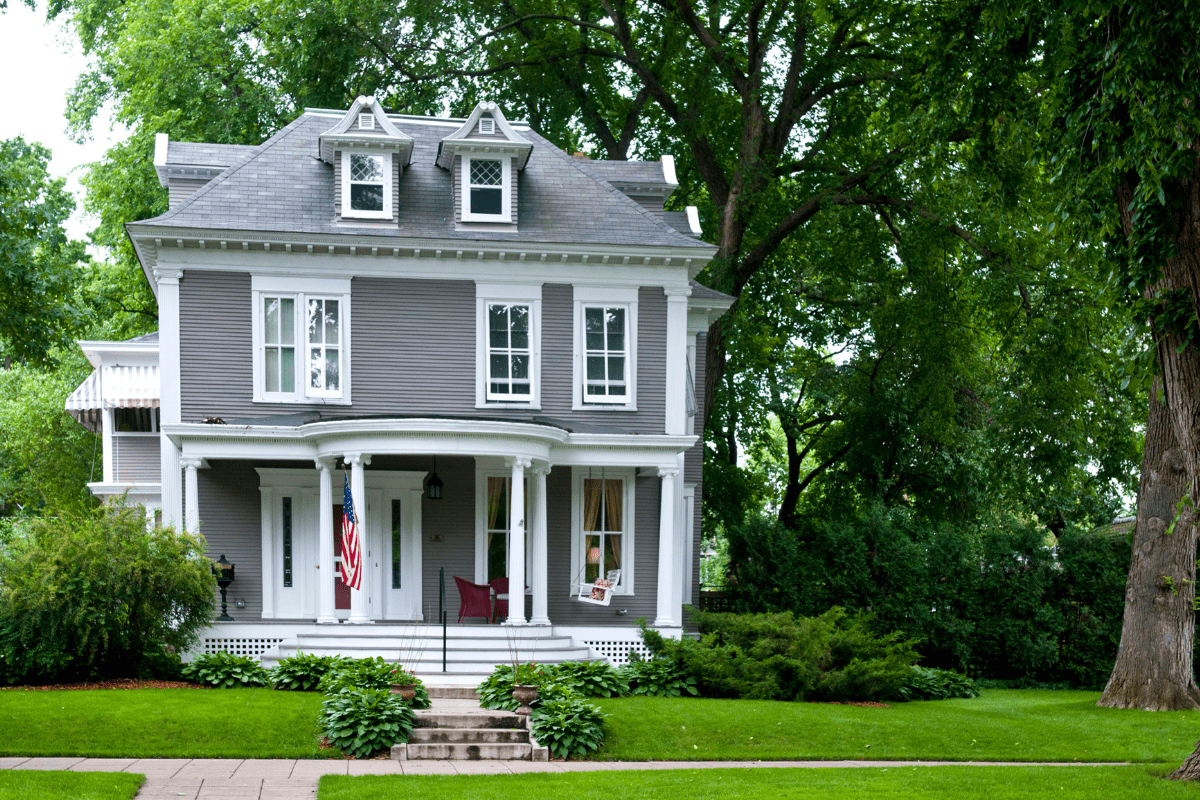Ever driven through a Tennessee neighborhood and wondered why some houses look like they're auditioning for a country music video while others seem stolen from a Victorian ghost story? You're not alone. Tennessee's architectural landscape reads like a really long, slightly confusing family reunion where colonial log cabins sit next to Victorian mansions, and everyone's arguing about whether those new "tall skinny" houses belong at the table.
The lay of the land shapes the homes we build
Before we dive into the specific styles that make Tennessee neighborhoods so visually… interesting… let's talk geography. Because it turns out, when you live in a state that stretches from the Appalachian Mountains to the Mississippi River, your houses start looking pretty different depending on which end you're on.
East Tennessee's mountainous terrain basically forced early settlers to get creative with logs and stones. I mean, when you're surrounded by trees and rocks, you work with what you've got. Middle Tennessee hit the jackpot with limestone deposits, which is why Nashville has all those fancy Federal-style buildings that make you feel underdressed just walking past them. And West Tennessee? Well, they took one look at the Mississippi River and said "let's build everything on stilts," which honestly seems pretty smart when you think about it.
Climate plays architect too
Here's a fun fact that'll make you appreciate your air conditioning: Tennessee averages 56.4% humidity with about 51 inches of rain annually. That's why every old house you see has those deep porches and high ceilings… our ancestors weren't just being fancy, they were trying not to melt. Those design choices that seem quaint now were basically survival tactics in the pre-AC era.
Colonial architecture: When log cabins were high-tech
The colonial period in Tennessee (roughly 1770s to 1850s) was like the Wild West meets This Old House. Settlers from Pennsylvania, Virginia, and Maryland showed up with their European building ideas and immediately realized that fancy brick townhouses weren't exactly practical when your nearest neighbor was a bear.
The fancier colonial homes featured symmetrical facades with two stories and central hallways that acted like wind tunnels (in a good way). But let's be honest, most people were living in log cabins, which came in four exciting varieties:
- Single pen (one room, very cozy)
- Double pen (two rooms, twice the luxury)
- Saddlebag (shared chimney, shared warmth)
- Dogtrot (two cabins with breezeway)
The dogtrot deserves its own moment
Okay, can we talk about how genius the dogtrot design was? Picture two log cabins connected by a covered breezeway where, yes, dogs would trot through (hence the name). But more importantly, this breezeway created natural air conditioning by funneling breezes through the structure. It's like our ancestors invented the first sustainable architecture without even trying.
If you want to see colonial done right, check out Cragfont in Castalian Springs. Built between 1798 and 1802 from gray limestone quarried on-site, this T-shaped Georgian beauty makes you wonder why we ever stopped building houses that could double as fortresses.
Victorian homes: Because more is more
From the 1850s through the 1910s, Tennessee went through what I like to call its "extra" phase. Victorian architecture arrived like that friend who shows up to casual Friday in a three-piece suit with a top hat. The Queen Anne style dominated from 1880 to 1910, and these houses had everything:
- Complex rooflines that made roofers cry
- Asymmetrical designs (symmetry is so colonial)
- Towers and turrets (for princess moments)
- Wraparound porches with spindle work
- 12-foot ceilings (heat rises, remember?)
- Stained glass windows everywhere
Memphis created an entire Victorian Village Historic District along Adams Avenue that was basically "Millionaire's Row" for cotton magnates. The Woodruff-Fontaine House and Mallory-Neely House still stand there, making the rest of us feel architecturally inadequate.
Nashville's Victorian neighborhoods tell stories
Nashville's Victorian homes spread across neighborhoods like Germantown and East Nashville's Lockeland Springs. These areas preserve everything from working-class Victorian cottages to grand Queen Anne mansions that currently sell for anywhere between $350,000 and $2.3 million. Yes, you read that right. That gingerbread trim doesn't come cheap.
The best part about Tennessee's Victorian homes? They adapted to our climate with deeper porches and higher foundations than their northern cousins. Even Victorian architects knew you can't fight Tennessee humidity… you just build around it.
Craftsman style: When America discovered chill
Around 1905, Tennessee homebuilders collectively decided that maybe, just maybe, Victorian houses were a bit much. Enter the Craftsman movement, which was basically the architectural equivalent of switching from a tuxedo to your favorite jeans.
These bungalows promoted radical ideas like "harmony with nature" and "exposed structural elements." Revolutionary stuff. Gustav Stickley's "The Craftsman" magazine spread the gospel, and suddenly everyone wanted:
- Low-pitched roofs with wide eaves
- Exposed rafters (hiding them is dishonest!)
- Full-width porches with tapered columns
- Natural materials (goodbye, paint everything)
- Built-in furniture (minimalism before it was cool)
Where to find these practical beauties
Nashville's Craftsman homes clustered in streetcar suburbs because, surprise surprise, people wanted to live near public transit even in the 1920s. The Belmont-Hillsboro area, now on the National Register of Historic Places, preserves excellent examples with local touches like limestone foundation piers.
Currently, there are about 21 Craftsman homes for sale in Nashville with a median price around $529,000. That's a lot of money for exposed rafters, but hey, authenticity has its price. These neighborhoods… 12 South, Sylvan Park, and Lockeland Springs… remain some of Nashville's most walkable and charming areas.
Ranch homes: Suburban dreams go horizontal
The ranch style arrived in Tennessee like a practical friend who shows up with casseroles and common sense. From the 1940s through the 1970s, these single-story wonders transformed suburban landscapes faster than you can say "attached garage."
Tennessee's ranch story has a unique twist: Oak Ridge's Manhattan Project. When you're building a secret city to develop atomic weapons, you need housing fast. The prefabricated "alphabet houses" they created became templates for efficient, modern living. Who knew nuclear physics would influence suburban architecture?
The ranch recipe for success
Ranch homes followed a simple formula that worked:
- Single-story layout (stairs are overrated)
- Attached garage (rain happens)
- Open floor plans (walls are overrated too)
- Picture windows (nature documentaries, live)
- 1,000 to 2,000 square feet
Knoxville's Cumberland Estates, developed from 1955 to 1965, shows how ranch homes conquered Tennessee. Spread across 3.5 square miles with houses originally priced around $18,000, this development adapted ranch designs to East Tennessee's hills with basement variations. Today, you'll find 4,995 ranch homes for sale statewide, averaging $340,000 in Knoxville. They're especially popular with retirees who've decided stairs are their enemy and younger buyers who think mid-century modern is vintage cool.
Contemporary architecture: Tennessee gets weird (in a good way)
Since 2000, Tennessee architecture has been having an identity crisis, and honestly? It's working. Modern designers are mixing contemporary ideas with regional traditions like a DJ mixing country and techno… sometimes it's amazing, sometimes it's confusing, but it's never boring.
The Music City Center earned LEED Gold certification with 845 solar panels and a 360,000-gallon rainwater collection system. Because if you're going to build big, might as well save the planet while you're at it.
The tall skinny phenomenon
Let's address the elephant in the room… or rather, the giraffe. Nashville's "tall skinny" homes exploit a 1990 state law that allows two homes where one used to stand. These Horizontal Property Regime structures (yes, that's the real term) feature:
- Tuck-under garages
- 2-3 stories of vertical living
- Minimal yard space
- Maximum neighborhood controversy
With tens of thousands built over 15 years, these homes provide relatively affordable ownership in expensive neighborhoods. They're like the architectural equivalent of skinny jeans… not for everyone, but definitely making a statement.
Modern meets traditional
Some architects are taking Tennessee's historic styles and giving them contemporary makeovers. Sanders Pace Architecture creates modern dogtrot houses with black metal cladding and floor-to-ceiling windows. It's like your great-great-grandfather's cabin went to design school.
The "New Farmhouse" trend moves beyond stark white minimalism to warmer designs that actually look like someone might live there. Projects like Alta Farms at Cane Ridge show how multifamily developments can incorporate farmhouse elements without looking like a barn convention.
Major developments like Nashville's East Bank (22 million square feet!) and Nashville Yards reshape urban cores with sustainable features and walkable designs. They're trying to build the future while nodding to the past, which is either brilliant or confusing depending on your perspective.
Regional flavors: Why location matters
Tennessee's three regions developed distinct architectural personalities, kind of like siblings who grew up in different houses.
East Tennessee's mountain architecture is all about working with slopes and weather. Log and stone construction dominates, with basement foundations carved into hillsides and steep roofs designed to shed snow. When your average temperature is 44°F, you build accordingly.
Middle Tennessee hit the geological lottery with limestone deposits, leading to those honey-colored Federal and Greek Revival buildings that make the area look dignified. The relatively flat Nashville Basin encouraged sprawling designs with wide central halls and porches that seem to go on forever.
West Tennessee took its cues from the Mississippi Delta, with raised foundations (floods are real, y'all) and shotgun houses that maximized narrow urban lots. Memphis developed its own commercial architecture for the cotton trade while residential areas reflected the diverse cultures that river commerce brought to town.
Preserving the past while building the future
Tennessee takes its architectural heritage seriously, with over 160,000 structures documented through preservation surveys. The Tennessee Historical Commission has facilitated $1.5 billion in historic building investments through federal tax credit programs. That's a lot of money spent making old buildings new again.
Organizations like Historic Nashville (founded 1968) and the Association for the Preservation of Tennessee Antiquities (the granddaddy, founded 1951) work to save buildings that might otherwise become parking lots. Memphis's Victorian Village shows how preservation can work… those Gilded Age mansions now house museums, restaurants, and bed-and-breakfasts.
The money side of preservation
Here's something that might surprise you: historic homes appreciate at 5% annually statewide, with Nashville's historic districts seeing 15% sales increases in 2024. Those federal tax credits offer 20% back for certified historic rehabilitation, though advocates keep pushing for state-level credits like 39 other states have. Learn more about tax credits if you're thinking about tackling a historic property.
What this means for you
Whether you're house hunting, history buffing, or just trying to win neighborhood trivia night, understanding Tennessee's architectural styles helps decode our built environment. Each style tells a story about who we were and who we're becoming.
Victorian mansions in prime Nashville neighborhoods command $350,000 to $2.3 million for those who want maximum drama. Craftsman bungalows average $529,000 for buyers seeking that perfect balance of character and practicality. Ranch homes offer single-story convenience around $340,000 in Knoxville for those who've sworn off stairs forever. And contemporary options? Well, they're all over the map, literally and price-wise.
Tennessee's architectural diversity means there's something for everyone, whether you dream of wraparound porches, exposed rafters, or whatever those tall skinny houses are doing. Our buildings reflect our geography, climate, and cultural evolution… from dogtrot cabins cooling frontier families to LEED-certified buildings cooling the planet.
The next time you drive through a Tennessee neighborhood, you'll see more than just houses. You'll see the stories of settlers adapting to new lands, Victorian entrepreneurs showing off their success, practical builders creating affordable suburbs, and modern architects trying to honor the past while building the future. It's messy, it's complicated, and it's absolutely, uniquely Tennessee.





